Fiber Bragg Grating Sensors
Grating Fabrication Facility
We are using in-house fabricated FBGs for our research purpose. In Grating Fabrication facility, Phase mask technique is used to fabricate the FBGs with different Bragg wavelengths such as 650 nm, 1060 nm, and different Bragg wavelengths in between 1530-1575 nm. FBG is fabricated by placing photosensitive fiber after Phase mask and illuminating with excimer Laser having a wavelength of 248 nm
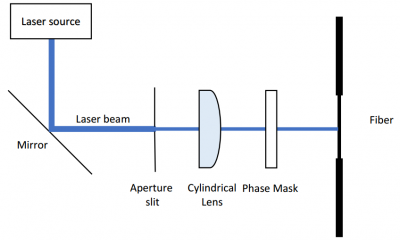
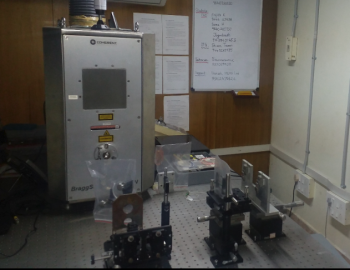
Fig: Schematic of fabrication of FBG and Grating Fabrication Facility
Structural Health monitoring using FBGs:
The harnessing of ultrasonic guided waves confined in local features such as bends and welds, known as feature-guided waves, has emerged as a promising technique for non-destructive testing and structural health monitoring of industrial and aerospace structures. Fiber Bragg grating based technique uses feature-guided waves to detect anomalies or defects in plate structures with transverse bends. We are able to obtain good consistency between simulation and experimental results, both in the case of defect-free bent plates and those with transverse defects. Such results establish fiber Bragg gratings as a viable alternative to conventional techniques for structural health monitoring of bent plates
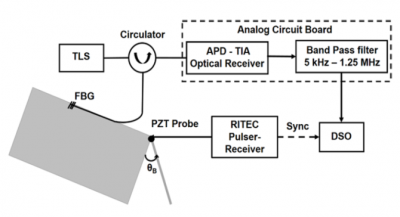
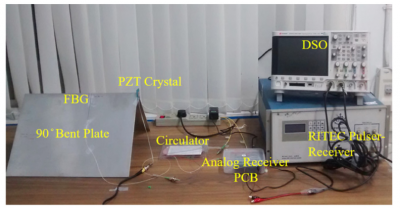
Ongoing research is on Structure health monitoring (SHM) of composites, which plays a vital role in the Aerospace industry. Defect identification is a part of SHM. The usage of composites has increased rapidly due to their light weight and stiffness. These composites are not like metals, they may give little or no warning before failing. These material failures like delamination will cause severe damage. Using guided waves and embedding FBG in laminates will help to detect the material defects at earlier stage thereby avoiding severe damage. Interrogation with guided waves are attractive as it provides defect identification and localization. FBGs are widely adapted in SHM due to their rugged wavelength-encoded transduction mechanism, immunity to EM interference, ability to sense multiple parameters like temperature and strain, compact in size and less cost compared to conventional sensors
Detection of partial discharges in power transformers using FBG sensors:
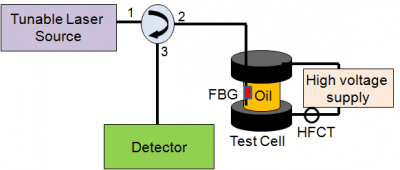 The primary goal of any power distribution network is to guarantee uninterrupted power supply to the consumer. One of the critical components in such a power distribution network is the power transformer. However, they are susceptible to breakdown primarily due to improper insulation design or poor quality of insulation structure or casing. As such, condition monitoring of transformer insulation forms an integral step in ensuring consistent operation of the power equipment. Partial discharges (PD), which consists of highly localized electric discharges occurring in the insulation serve as early indicators of such insulation degradation. Our research is focussed on using FBG sensors to detect the acoustic waves emitted from PD.
We aim to develop a sensor system to detect, classify and locate PD. FBG sensor is pasted on the wall of the test cell and is subject to acoustic waves emitted from PD. Acoustic signals are captured in an in-house developed optical receiver using the tunable laser based interrogation technique. We plan to classify PD exploiting the fact that each type of PD exhibits a specific acoustic spectral signature. We have also carried out investigations on Cross Recurrence Plot Analysis based technique for localizing discharges.
The primary goal of any power distribution network is to guarantee uninterrupted power supply to the consumer. One of the critical components in such a power distribution network is the power transformer. However, they are susceptible to breakdown primarily due to improper insulation design or poor quality of insulation structure or casing. As such, condition monitoring of transformer insulation forms an integral step in ensuring consistent operation of the power equipment. Partial discharges (PD), which consists of highly localized electric discharges occurring in the insulation serve as early indicators of such insulation degradation. Our research is focussed on using FBG sensors to detect the acoustic waves emitted from PD.
We aim to develop a sensor system to detect, classify and locate PD. FBG sensor is pasted on the wall of the test cell and is subject to acoustic waves emitted from PD. Acoustic signals are captured in an in-house developed optical receiver using the tunable laser based interrogation technique. We plan to classify PD exploiting the fact that each type of PD exhibits a specific acoustic spectral signature. We have also carried out investigations on Cross Recurrence Plot Analysis based technique for localizing discharges.
Detecting Onset of Combustion Instability in Gas Turbines Through Fiber Optic Sensors
Combustion instability arises due to the coupling between unsteady heat release and acoustics of the chamber. Due to this coupling, high amplitude oscillations occur at the resonant acoustic mode of the combustor and . These oscillations are often self-sustaining and damaging to the system. In addition to causing extreme annoyance, combustion instability can result in hardware damage and can reduce the efficiency of the combustion system.
Several approaches have been proposed to address this issue by finding precursors which can sense features that help to detect and characterize combustion instability. While most of the existing methods utilize a single sensor to predict instability, most robust approach so far uses data from heterogeneous (e.g. pressure and chemiluminescence) sensors and models spatiotemporal co-dependence among time series from the sensors to generate a data-driven precursor which is uniformly applicable across multiple experiment protocols with various premixing levels. This method exhibits robustness to varying levels of sensor noise when compared to other existing methods.

Along this line, we are proposing a method where the chemi-luminescence sensor may be replaced by fiber optic bundle and the pressure sensor can be replaced by the FBG which offers advantages like immunity to electromagnetic interference, small size and multiplexing capability. In short, we are planning to provide a complete fiber optic solution for predicting combustion instability.
Ongoing work is mainly to overcome the challenge faced by sensors in high-temperature environment of the combustor. Conventional FBG exhibits poor stability within the high-temperature environment and the grating can be completely erased at temperatures around 700 °C. We are planning to address this issue by using annealed FBGs and by designing suitable packaging for sensors to isolate high temperature.